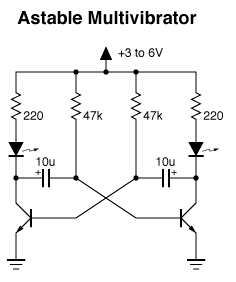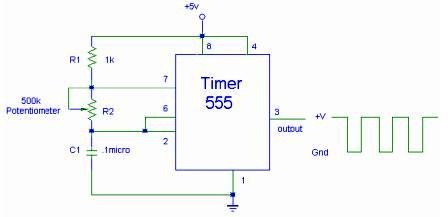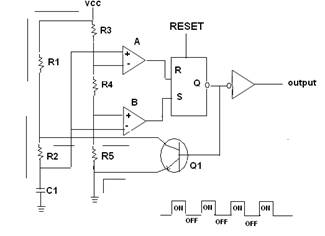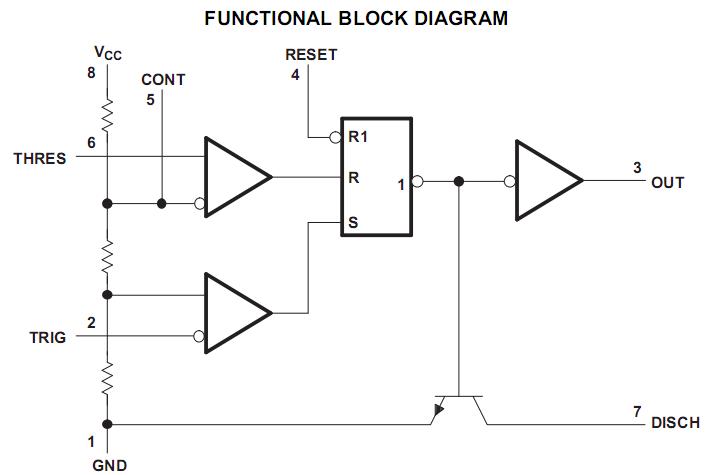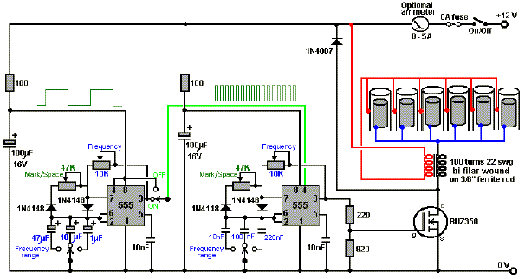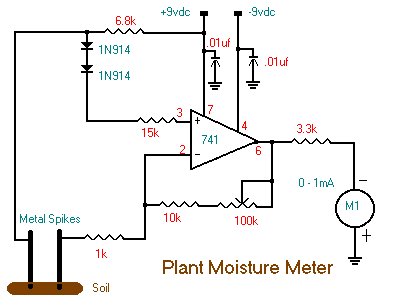
741 Astable Timer
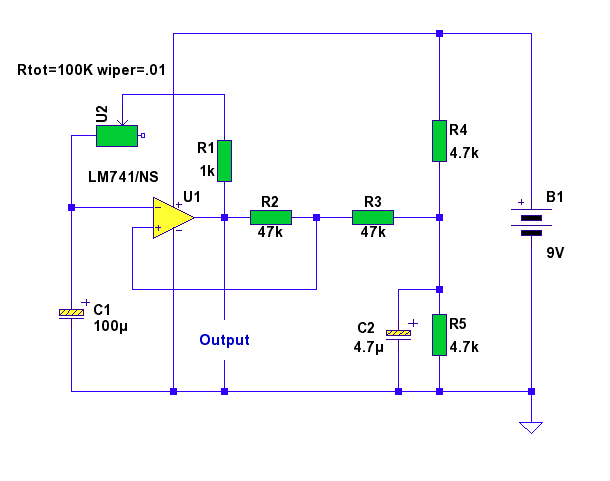
In this circuit, a standard operational amplifier (op-amp) is configured as an astable multivibrator. The output is non-symmetrical, but it has the advantage of being controlled by only one resistor and one capacitor: a 100k variable resistor (U2) and a 100µF capacitor (C1). Due to the high loop gain, the output rise and fall times are very low, achieving slope times better than 30µs even with a 5V supply. The waveforms are illustrated below: the green trace represents the output voltage at pin 6 of the op-amp, the blue trace indicates the voltage at pin C, which corresponds to the charge and discharge of C1, and the voltage at pin 3 of the op-amp is depicted in red. The pinout for the 741 op-amp is provided below: the inverting input is pin 2, and the non-inverting input is pin 3 in the schematic. The timing characteristics are also shown below. The "on" time corresponds to the positive half-cycle, while the "off" time refers to the negative cycle; however, since it operates from a single supply, the off voltage is slightly higher than 1 Volt. The frequency of oscillation is the reciprocal of one half positive and one half negative cycle.
The astable multivibrator configuration using an op-amp, such as the 741, creates a square wave output without requiring any external triggering. The circuit's operation is based on the charging and discharging cycles of the capacitor C1 through the resistor U2. As the capacitor charges through the resistor, the voltage across it rises until it reaches a threshold determined by the op-amp's internal reference levels. At this point, the op-amp switches its output state, causing the capacitor to discharge through the resistor, resulting in a square wave output.
In this case, the variable resistor allows for fine-tuning of the frequency of oscillation. By adjusting the resistance value, the time constants for charging and discharging the capacitor change, directly affecting the frequency of the output waveform. The output frequency can be calculated using the formula:
\[ f = \frac{1}{T} = \frac{1}{(R \cdot C \cdot \ln(2))} \]
Where \( R \) is the resistance in ohms, \( C \) is the capacitance in farads, and \( T \) is the period of the waveform. The non-symmetrical nature of the output waveform indicates that the time spent in the high state differs from the time spent in the low state, which can be beneficial for certain applications that require specific duty cycles.
The op-amp's high gain ensures that the output transitions are rapid, contributing to the low rise and fall times observed in the output waveform. This characteristic is particularly advantageous in applications where fast switching is essential, such as in pulse-width modulation (PWM) or timing applications.
It is important to ensure that the op-amp is powered correctly, and the input pins are connected appropriately to avoid damage. The output can be interfaced with other components in a circuit, such as LEDs, transistors, or microcontrollers, for various applications, including signal generation, clock pulses, and timing applications.In this circuit a standard op-amp is wired as an astable multivibrator. The output is non-symmetrical but has the advantage that the timing is controlled by only 1 resistor and capacitor, in this case, the 100k variable resistor, U2 and 100u capacitor C1. Because of the high loop gain the output rise and fall times are very low, slope times better than 30uS can be acheived even with a 5V supply. Waveforms are shown below: The green trace is the output voltage at Pin 6 of the op-amp, the blue trace is the voltage at Pin C and also the charge and discharge of C1, and the voltage at the op-amps pin 3 is shown in red. The pinout for the 741 is shown below: Please note that the the inverting input is pin 2 and non-inverting input is pin 3 on the in the schematic.
The timing is shown below. The "on" time is for a positive half cycle, "off" time is the negative cycle, although being run from a single supply, the off voltage is slightly higher than 1 Volt. The frequency is the reciprocal of one half postive and one half negative cycle. 🔗 External reference
The astable multivibrator configuration using an op-amp, such as the 741, creates a square wave output without requiring any external triggering. The circuit's operation is based on the charging and discharging cycles of the capacitor C1 through the resistor U2. As the capacitor charges through the resistor, the voltage across it rises until it reaches a threshold determined by the op-amp's internal reference levels. At this point, the op-amp switches its output state, causing the capacitor to discharge through the resistor, resulting in a square wave output.
In this case, the variable resistor allows for fine-tuning of the frequency of oscillation. By adjusting the resistance value, the time constants for charging and discharging the capacitor change, directly affecting the frequency of the output waveform. The output frequency can be calculated using the formula:
\[ f = \frac{1}{T} = \frac{1}{(R \cdot C \cdot \ln(2))} \]
Where \( R \) is the resistance in ohms, \( C \) is the capacitance in farads, and \( T \) is the period of the waveform. The non-symmetrical nature of the output waveform indicates that the time spent in the high state differs from the time spent in the low state, which can be beneficial for certain applications that require specific duty cycles.
The op-amp's high gain ensures that the output transitions are rapid, contributing to the low rise and fall times observed in the output waveform. This characteristic is particularly advantageous in applications where fast switching is essential, such as in pulse-width modulation (PWM) or timing applications.
It is important to ensure that the op-amp is powered correctly, and the input pins are connected appropriately to avoid damage. The output can be interfaced with other components in a circuit, such as LEDs, transistors, or microcontrollers, for various applications, including signal generation, clock pulses, and timing applications.In this circuit a standard op-amp is wired as an astable multivibrator. The output is non-symmetrical but has the advantage that the timing is controlled by only 1 resistor and capacitor, in this case, the 100k variable resistor, U2 and 100u capacitor C1. Because of the high loop gain the output rise and fall times are very low, slope times better than 30uS can be acheived even with a 5V supply. Waveforms are shown below: The green trace is the output voltage at Pin 6 of the op-amp, the blue trace is the voltage at Pin C and also the charge and discharge of C1, and the voltage at the op-amps pin 3 is shown in red. The pinout for the 741 is shown below: Please note that the the inverting input is pin 2 and non-inverting input is pin 3 on the in the schematic.
The timing is shown below. The "on" time is for a positive half cycle, "off" time is the negative cycle, although being run from a single supply, the off voltage is slightly higher than 1 Volt. The frequency is the reciprocal of one half postive and one half negative cycle. 🔗 External reference
